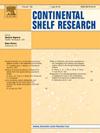圭亚那盆地(大西洋)地表水的生物生产力:新的综合方法
IF 2.2
3区 地球科学
Q2 OCEANOGRAPHY
引用次数: 0
摘要
本研究的目的是评估圭亚那盆地地表水的生物生产力和营养,以确定浮游植物-海洋生态系统状态的标志-发育的有利条件。利用浮游植物(种类和定量分析)数据和生物化学参数(三磷酸腺苷和叶绿素a浓度),采用一种新的综合方法来确定群落的成熟阶段和营养类型。这些数据要么来自2022年冬季巡航期间的现场测量和采样,要么来自卫星观测。结合非生物因素(温度、盐度、溶解氧、磷酸盐浓度)对0-50 m光层的浮游植物分布进行了分析。总的来说,我们研究的主要发现是在Vema断裂带(中营养水域)自养生物占优势,硅藻微藻占主导地位(对应于平衡群落);而在圭亚那部分低营养水域,异养生物普遍存在,以双藻微藻为主(对应于发达和成熟的群落)。异养光自养指数(HPI)证实了这种分布。结果表明,研究区浮游植物的冬季分布及其群落的成熟程度与北巴西流-北赤道逆流系统对亚马逊水的平流提供的营养物质有关。本文章由计算机程序翻译,如有差异,请以英文原文为准。

Bioproductivity of the surface waters in the Guiana Basin (Atlantic ocean): new integrated approach
The purpose of this research to assess bioproductivity and trophicity of surface waters in the Guiana Basin to identify favorable conditions for the development of phytoplankton – a marker of the ocean ecosystem state. We use of data on phytoplankton (species and quantitative analysis) and biochemical parameters (concentrations of adenosine triphosphate and chlorophyll a) to determine the maturity stages and nutritional type of the communities using a new integrated approach. These data are obtained either from in situ measurements and sampling during a cruise in winter 2022, or satellite observations. An analysis of the phytoplankton distribution was carried out in conjunction with abiotic factors (temperature, salinity, dissolved oxygen, phosphate concentrations) for the photic layer 0–50 m. Generally, the main finding of our study is that in the Vema Fracture zone (mesotrophic waters) autotrophs prevail with the dominance of diatom microalgae (corresponding to equilibrium community); whereas in the Guiana section oligotrophic waters) heterotrophs prevail with the dominance of dinophytic microalgae (corresponding to developed and mature communities). This distribution is confirmed by the heterotrophic photoautotrophic index values (HPI). Concluding a discussion, we show that winter distribution of phytoplankton and the maturity degree of its community in the study area, are associated with the supply of nutrients due to the advection of Amazon waters by the North Brazil Current – North Equatorial Countercurrent system.
求助全文
通过发布文献求助,成功后即可免费获取论文全文。
去求助
来源期刊

Continental Shelf Research
地学-海洋学
CiteScore
4.30
自引率
4.30%
发文量
136
审稿时长
6.1 months
期刊介绍:
Continental Shelf Research publishes articles dealing with the biological, chemical, geological and physical oceanography of the shallow marine environment, from coastal and estuarine waters out to the shelf break. The continental shelf is a critical environment within the land-ocean continuum, and many processes, functions and problems in the continental shelf are driven by terrestrial inputs transported through the rivers and estuaries to the coastal and continental shelf areas. Manuscripts that deal with these topics must make a clear link to the continental shelf. Examples of research areas include:
Physical sedimentology and geomorphology
Geochemistry of the coastal ocean (inorganic and organic)
Marine environment and anthropogenic effects
Interaction of physical dynamics with natural and manmade shoreline features
Benthic, phytoplankton and zooplankton ecology
Coastal water and sediment quality, and ecosystem health
Benthic-pelagic coupling (physical and biogeochemical)
Interactions between physical dynamics (waves, currents, mixing, etc.) and biogeochemical cycles
Estuarine, coastal and shelf sea modelling and process studies.
 求助内容:
求助内容: 应助结果提醒方式:
应助结果提醒方式:


